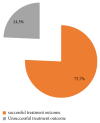Predictors of Treatment Outcomes among Multidrug Resistant Tuberculosis Patients in Tanzania
- PMID: 30891315
- PMCID: PMC6390242
- DOI: 10.1155/2019/3569018
Predictors of Treatment Outcomes among Multidrug Resistant Tuberculosis Patients in Tanzania
Abstract
Background: According to World Health Organization (WHO) the final multidrug resistant tuberculosis (MDRTB) treatment outcome is the most important direct measurement of the effectiveness of the MDRTB control program. Literature review has shown marked diversity in predictors of treatment outcomes worldwide even among the same continents. Therefore, findings could also be different in Tanzanian context, where the success rate is still lower than the WHO recommendation. This study sought to determine the predictors of treatment outcomes among MDRTB patients in Tanzania in order to improve the success rate.
Methodology: This was a retrospective cohort study, which was conducted at Kibong'oto Infectious Diseases Hospital (KIDH) in Tanzania. Patients' demographic and clinical parameters were collected from the MDRTB registry and clinical files. Then, a detailed analysis was done to determine the predictors of successful and unsuccessful MDRTB treatment outcomes.
Results: Three hundred and thirty-two patients were diagnosed and put on MDRTB treatment during the year 2009 to 2014. Among them, males were 221 (67%), and 317 (95.48%) were above 18 years of age, mean age being 36.9 years. One hundred and sixty-one patients (48.5%) were living in Dar es Salaam. The number of MDRTB patients has increased from 16 in 2009 to 132 in 2014. Majority of patients (75.7%) had successful treatment outcomes. The following predictors were significantly associated with MDRTB cure: presence of cavities in chest X-rays (aOR 1.89, p value 0.002), low BMI (aOR 0.59, p value 0.044), and resistance to streptomycin (aOR 4.67, p value 0.007) and ethambutol (aOR 0.34, p value 0.041). Smoking and presence of cavities in chest X-rays were associated with MDRTB mortality, aOR 2.31, p value 0.043 and aOR 0.55, p value 0.019, respectively.
Conclusion: The study indicated that overall number of MDRTB patients and the proportion of successful treatment outcomes have been increasing over the years. The study recommends improving nutritional status of MDRTB patients, widespread antismoking campaign, and close follow-up of patients with ethambutol resistance.
Figures




References
-
- WHO. GLOBAL TUBERCULOSIS REPORT 2016, 2016.
-
- WHO. The Global Plan to Stop TB: 2011-2015. 2010, http://www.stoptb.org.
-
- WHO. Multidrug-Resistant Tuberculosis (MDR-TB) Indicators. 2010, https://apps.who.int/iris/bitstream/handle/10665/70484/WHO_HTM_TB_2010.1.... - DOI
-
- Elmi O. S., Hasan H., Abdullah S., Mat Jeab M. Z., BA Z., Naing N. N. Treatment outcomes of patients with multidrug-resistant tuberculosis (MDR- TB) compared with Non-MDR-TB infections in peninsular malaysia. Malaysian Journal of Medical Sciences. 2016;23(4):17–25. doi: 10.21315/mjms2016.23.4.3. - DOI - PMC - PubMed
-
- WHO. WHO treatment guidelines for drug-resistant tuberculosis. 2016.
LinkOut - more resources
Full Text Sources

